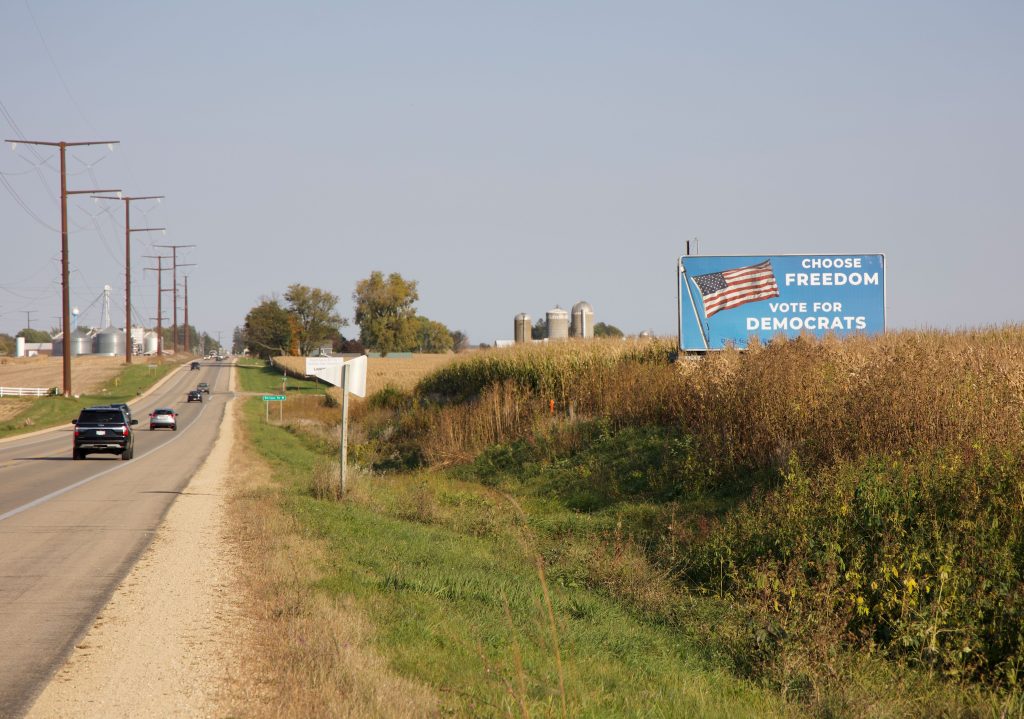WAUSAU, Wisconsin — Democrats have spent 12 years and hundreds of millions of dollars fighting for a chance to dismantle the dominant conservative majorities that locked them out of power in Wisconsin’s statehouse.
But to regain clout in Madison, they’ll need to rebuild trust with voters in a place that’s become increasingly hostile to Democrats nationwide: rural America.
Democrats have a shot in Wisconsin thanks to new voting maps passed after the state’s liberal-controlled high court tossed out the ones crafted by Republicans to tilt in their favor.
“We feel the wind in our sails,” Assembly Minority Leader Greta Neubauer said. “There are Democrats all across the state, and many of those voters have not been able to make their voices heard in legislative elections because of the gerrymander.”
With Congress hamstrung by divided control, state legislatures are increasingly setting the country’s policy agenda. That shift has morphed tight contests for statehouses into expensive, high-stakes affairs in places like Arizona, Michigan, Pennsylvania and Wisconsin.
Democrats have their work cut out for them in the Dairy State. They’ve been run out of wide swaths of rural Wisconsin over the past two decades as many once-purple communities in the state’s less-populous north and west took a sharp right turn.
Republicans boast a commanding 64-34 majority in the state Assembly, and while new maps all but guarantee that edge will slip, pundits watching the race expect the GOP to retain a slim majority. Winning back the state Senate from a Republican supermajority is out of the question, since new maps won’t fully kick in there until 2026.
Republican leaders are banking that a deep bench of incumbents and a track record of delivering tax cuts will keep rural voters in their camp. Robin Vos, the powerful Republican Assembly speaker for more than a decade, said he’d bet his “bottom dollar” the GOP will remain in the majority come 2025.
“We are working harder, doing more doors, putting in the grassroots effort that has allowed us to be victorious over the course of the past 30 years,” Vos said.
But Democrats are looking to continue a recent string of success in statewide races after winning back the governor’s mansion in 2018 and flipping the state’s Supreme Court from conservative to liberal in 2023. They’re pouring money into more than a dozen battleground seats unlocked by new maps. And in a show of force, the party is contesting 97 of Wisconsin’s 99 Assembly districts, its largest recruitment effort since 2011.
Should liberals pull off the upset in Wisconsin, their strategy could become a blueprint for Democrats across the country searching for a way to halt the red tidal wave that’s washed over the American heartland.
“We see a slightly Democratic leaning overall environment,” Neubauer said. “That’s an environment in which we can win a majority.”
No home field advantage
Wisconsin Democrats will need to step out of their comfort zone to win back the Assembly.
The party’s battle-tested strategy for winning statewide races — overwhelming turnout in Democratic strongholds like Dane and Milwaukee counties paired with overperformance in suburban areas that used to vote reliably Republican — won’t be enough to hand them the majority.
Instead, the tipping-point seat is likely somewhere along Highway 29, an east-west artery that reaches across the state’s largely rural center and runs right through Wausau, where Democrat Yee Leng Xiong is looking to oust four-term GOP Rep. Patrick Snyder.
Snyder’s district is centered around this manufacturing and agriculture hub of about 40,000 people. Republicans flipped the historically blue seat in 2014 thanks to friendly maps and growing rural support for the GOP.
“We win that one, [it’s] very likely to be the seat that would give us the majority,” Neubauer said.
Xiong, a local school board member and former executive director of Wausau’s Hmong American Center, has been on Democrats’ radar for years. He finally decided to run for the seat after the state Supreme Court ordered new maps last December. He would be Wisconsin’s first Hmong American legislator if he wins in November.
“I’m really fortunate this district is 50-50,” said Xiong, who described himself as “annoyingly moderate” with a penchant for bipartisanship. “If it was too progressive, I probably wouldn’t win. If it was too conservative, I wouldn’t win.”
Snyder declined a request to comment.
But Xiong, like other Democrats running in rural areas, is up against a Republican operation that has had years to hone its rural campaigning skills.
Multiple Republican strategists who spoke with POLITICO said the party has a robust ground game focused on community events and a keen eye for recruiting strong candidates — an effort spearheaded by Vos.
“We want to find a person that has a record as an elected official, a community leader, a business leader, somebody who’s well-known in the community,” Vos said. “That person usually translates in because they don’t start with some hard ideological edge.”
Morgan Hess, executive director of the Assembly Democratic Campaign Committee, admitted the party has had trouble recruiting quality candidates to match Republicans in recent years, though she argues Republicans’ aggressive gerrymander played a sizable role in the challenge.
“It makes it hard to recruit good candidates,” Hess said. “When districts are specifically drawn to be noncompetitive, then it is harder to get local leaders to step up.”
Down to the ground game
Vos pointed to vulnerable incumbent Republican Rep. Todd Novak as a candidate-recruitment case study. On paper, Novak’s race in southwestern Wisconsin looks like a prime pickup opportunity for Democrats. The district, which covers small towns and dairy farms scattered across rolling hills west of Madison, leans Democratic after its boundaries were stretched east to pull in parts of solidly blue Dane County.
Yet Republicans have reason to believe he can keep his seat. Novak, who is openly gay, has a moderate streak, having supported nonpartisan redistricting before the state Supreme Court’s 2023 decision to order new maps. He’s knocked off tough Democratic challengers before, and campaign finance records from September show Novak has outraised and outspent his 2024 challenger, Elizabeth Grabe.
Novak did not respond to requests for comment.
With Republicans entrenched in rural areas, Democrats are going the extra mile to reach voters on the ground.
That’s how Grabe, a realtor who moved back to Wisconsin in 2005 to manage her family’s farm, found herself trekking up a winding gravel driveway in the tiny southwestern hamlet of Montfort after grabbing lunch at a local sports bar. She’s criss-crossed the 50-mile-wide district in her white SUV to reach voters, an effort the former triathlete compared to running a marathon after finishing a long bike ride.
“I don’t think I would have been able to do it if I didn’t have the background as an endurance athlete,” Grabe said.
Democrats are also playing defense in districts once considered safe under the old maps. In Eau Claire, a college town of about 70,000 people located 90 minutes east of Minneapolis, new maps cut parts of the city out of incumbent Democratic Rep. Jodi Emerson’s district and added in deep-red swaths of countryside to the east.
Her race against Republican challenger and county supervisor Michele Magadance Skinner is still rated “lean Democratic” by election forecasting site CNalysis, but she’s not taking anything for granted. The three-term incumbent said she’s made a point of traveling out to small towns like Augusta, where she spent a recent Saturday afternoon chatting with the staff of a local diner over lunch. (Skinner did not return requests for comment.)
“It matters to show up, be there, and be present in these communities,” Emerson said. “Even if I’m not winning votes, if I’m introducing myself to them and having a good conversation, my hope is I walk away with at least their respect.”
Money matters
Emerson and other Democrats looking to win over rural voters are campaigning on a slate of kitchen-table issues — greater funding for child care, public schools and local governments — they feel Republicans have neglected despite record state budget surpluses.
For example, city and county leaders have increasingly asked local taxpayers to foot the bill for municipal services like libraries and road construction when state aid comes up short. Democrats say the shortages are a direct result of Republican-imposed austerity.
“Rural folks are being impacted by this,” Xiong said. “The state legislature has been balancing its budget on the back of local government.”
They’re pushing a similar message on health care. Republicans have long opposed Medicaid expansion, making Wisconsin one of 10 states that has not approved benefits that the state’s health department estimates would extend medical coverage to nearly 90,000 residents.
Neubauer thinks these issues will resonate with voters. She was even willing to throw out a target number for Democrats — 52 seats — in an August interview with The Recombobulation Area, a local left-leaning politics blog.
Republicans are hustling to ward off a potential Democratic insurgency. GOP campaigns and conservative groups have swarmed the airwaves with ads painting Democrats as “out of touch” and “extreme” for opposing tax cuts during the last legislative session. Their counter-message is that lower taxes and less government spending will keep the state’s budget healthy and money in voters’ wallets.
“I’ve never had a person say we should expand welfare. I’ve never had a person bring up Medicaid expansion, not one. This is an example of projecting onto voters what you want them to believe, right?” Vos said. “The number one issue: jobs and the economy.”
Hammering high taxes and spending has served Republicans well. The issues fueled the party’s rise in 2010 behind then-Gov. Scott Walker, who made an explicit play for rural voters by promising to reallocate resources from Madison and Milwaukee to the rest of the state. He made good on promises to slash taxes, reject federal funding for a high-speed train connecting Madison and Milwaukee to Chicago and pass legislation that kneecapped public employees’ ability to collectively bargain.
“There’s some very legitimate reasons that people in rural areas feel like their economy and their way of life has been left behind,” said Brian Reisinger, a former Walker staffer who now works as a public affairs consultant and authored a recent book about rural economics. “I think that Governor Walker tapped into that by saying, ‘Hey, I’m fighting for you. I’m fighting for the taxpayer.’”
Yet Reisinger cautioned that Republicans’ advantage isn’t set in stone, especially as Democrats are making a more intentional play for rural voters.
“Republicans need to take notice,” he said. “Our politics are not static — it’s especially not the case in rural areas.”





